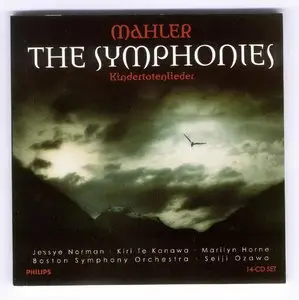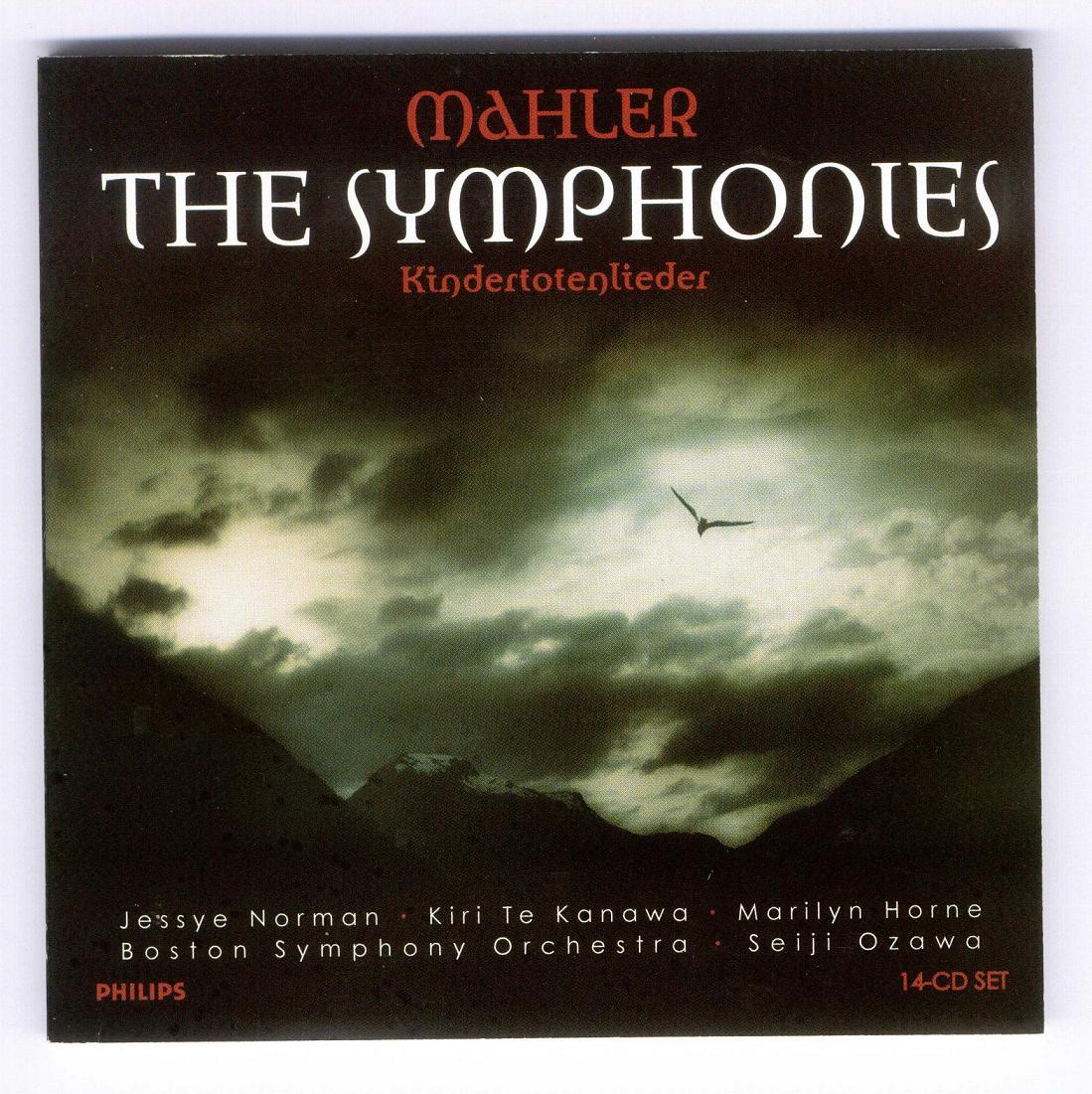Gustav Mahler : The Symphonies - Kindertotenlieder - cd 11 & 12 of 14 - Symphony #8 - various singers - Tanglewood Festival Chorus
Boston Symphony Orchestra - Seiji Ozawa
Unknown Rip | APE tracks (No Cue+No Log) | Complete Scans | 81 min. | 340 MB
20th Century Music | Orchestral Music | Choral Music | Vocal Music | Language: German | Philips 470 871-2 (14-CD set) | 2002
Boston Symphony Orchestra - Seiji Ozawa
Unknown Rip | APE tracks (No Cue+No Log) | Complete Scans | 81 min. | 340 MB
20th Century Music | Orchestral Music | Choral Music | Vocal Music | Language: German | Philips 470 871-2 (14-CD set) | 2002
It's a Finnwake personal rip (september 2010): 2 zip files with the 7 tracks of cd's 11 and 12 (of 14) on ape files (compressed from the original wave files), the 126 page boxset booklet (in English, German, French), plus the box cover and front and back cover of the two cd's.
http://www.amazon.com/Mahler-S...&qid=1283672921&sr=1-1
The Box Cover:
http://imageban.net/show/2010/...7301643c7978bb4451be4f6ddd/jpg
––––––––––––-
Gustav Mahler (7 July 1860 – 18 May 1911) was a late-Romantic Austrian composer and one of the leading conductors of his generation. As a composer, he acted as a bridge between the 19th century Austro-German tradition and the modernism of the early 20th century. While in his lifetime his status as a conductor was established beyond question, his own music gained wide popularity only after periods of relative neglect which included a ban on its performance in much of Europe during the Nazi era. After 1945 the music was discovered and championed by a new generation of listeners; Mahler then became one of the most frequently performed and recorded of all composers, a position he has sustained into the 21st century.
The Symphony No. 8 in E-flat major is one of the largest choral works in the classical concert repertory. Because it requires huge instrumental and vocal forces it is frequently called the "Symphony of a Thousand", though Mahler did not acknowledge the name. The work was composed in a single inspired burst, at Maiernigg in southern Austria in the summer of 1906. The last of Mahler's works that was premiered in his lifetime, the symphony was a critical and popular success when he conducted its first performance in Munich on 12 September 1910.
The fusion of song and symphony had been a characteristic of Mahler's early works. In his "middle" compositional period after 1901, a change of style led him to produce three purely instrumental symphonies. The Eighth, marking the end of the middle period, returns to a combination of orchestra and voice in a symphonic context. The architecture of the work is unconventional; instead of the normal framework of several movements, the piece is in two parts. Part I is based on the Latin text of a ninth-century Christian hymn for Pentecost, Veni creator spiritus ("Come, Creator Spirit"), and Part II is a setting of the words from the closing scene of Goethe's Faust. The two parts are unified by a common idea, that of redemption through the power of love, a unity conveyed through shared musical themes.
––––––––––––-
Track List:
Gustav Mahler (1860-1911)
Symphony No.8 in E flat major
[composed: 1906; First performance: September 12, 1910]
cd 1 (11 of 14) [23'07"]
Part I
[1] Hymnus: Veni, creator spiritus. Allegro impetuoso (23'07")
cd 2 (12 of 14) [58'08"]
Part II
(Final Scene from the second part of Goethe's Faust)
[1] Poco adagio (8'52")
[2] Waldung, sie schwankt heran. Chor und Echo (13'52")
[3] Uns bleibt ein Erdenrest. Die vollendeteren Engel (6'19")
[4] Dir, der Unberührbaren. Chor (15'07")
[5] Blicket auf zum Retterblick. Doctor Marianus (5'55")
[6] Alles Vergängliche. Chorus mysticus (6'02")
Faye Robinson, soprano I/Magna Peccatrix ; Judith Blegen, soprano II/Una Poenitentium ;
Deborah Sasson, soprano III/Mater Gloriosa ; Florence Quivar, contralto I/Mulier Samaritana ;
Lorna Myers, contralto II/Maria Aegyptiaca ; Kenneth Riegel, tenor/Doctor Marianus ;
Benjamin Luxon, baritone/Peter Exstaticus ; Gwynne Howell, bass/Peter Profundus
Tanglewood Festival Chorus ; Boston Boy Choir
Boston Symphony Orchestra
Seiji Ozawa
Recorded: Symphony Hall, Boston, November 1980.
––––––––––––-
Links:
cd 11 of 14
http://www.fileserve.com/file/NVABGFJ
http://www.multiupload.com/MWFKSP0C7M
cd 12 of 14
http://www.fileserve.com/file/cgAB98b
http://www.multiupload.com/6NS19IVQFJ
––––––––––––
Gustav Mahler (1860-1911)
Symphony No.8 in E flat major
[composed: 1906; First performance: September 12, 1910]
cd 1 (11 of 14) [23'07"]
Part I
[1] Hymnus: Veni, creator spiritus. Allegro impetuoso (23'07")
cd 2 (12 of 14) [58'08"]
Part II
(Final Scene from the second part of Goethe's Faust)
[1] Poco adagio (8'52")
[2] Waldung, sie schwankt heran. Chor und Echo (13'52")
[3] Uns bleibt ein Erdenrest. Die vollendeteren Engel (6'19")
[4] Dir, der Unberührbaren. Chor (15'07")
[5] Blicket auf zum Retterblick. Doctor Marianus (5'55")
[6] Alles Vergängliche. Chorus mysticus (6'02")
Faye Robinson, soprano I/Magna Peccatrix ; Judith Blegen, soprano II/Una Poenitentium ;
Deborah Sasson, soprano III/Mater Gloriosa ; Florence Quivar, contralto I/Mulier Samaritana ;
Lorna Myers, contralto II/Maria Aegyptiaca ; Kenneth Riegel, tenor/Doctor Marianus ;
Benjamin Luxon, baritone/Peter Exstaticus ; Gwynne Howell, bass/Peter Profundus
Tanglewood Festival Chorus ; Boston Boy Choir
Boston Symphony Orchestra
Seiji Ozawa
Recorded: Symphony Hall, Boston, November 1980.
––––––––––––-
Links:
cd 11 of 14
http://www.fileserve.com/file/NVABGFJ
http://www.multiupload.com/MWFKSP0C7M
cd 12 of 14
http://www.fileserve.com/file/cgAB98b
http://www.multiupload.com/6NS19IVQFJ
––––––––––––



